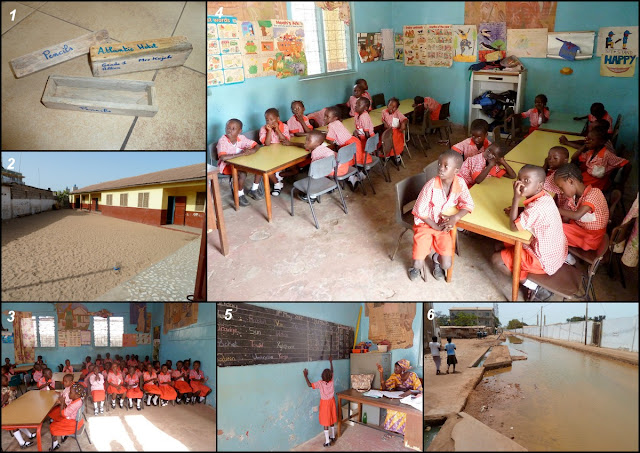We
saw a good number of animals in this reserve and we especially realised that
depending on the season, we would see more or less, particularly due to the
height of the vegetation. At the end of the dry season, when we went, the grass
is low and we had a far-reaching visibility. However, the moment the rain
arrives, high grass invades large swathes of land and many animals hide
themselves amongst the grass.

Close to the only water point, which was at a very low level at this end
of April, there were some monkeys. The Western red colobus (Piliocolobus
badius – top-left) which
resembles the Red colobus from the Bijilo forest, were on the ground which is
rare for them as they are usually tree-dwelling monkeys. In fact, there’s a
belief that when locals see one of these monkeys come down to the ground, many
children will break an arm. It’s an endangered monkey in Western Africa and the
male, larger than the female, can weigh up to 13kgs. They live in a large
family in forests where they like eating leaves and occasionally have a taste
of fruit and grain.
The Patas monkey (Erythrocerebus patas
– bottom left) is common in the Saharan Africa. Also known as the singe
pleureur [crying monkey] because it emits a sound that resembles that of a
baby, our guide deemed it “mischievous”. The male can reach 12kgs. They live in
the open savannah and feed on insects, tree sap, grains, and tubers. It’s the
fastest primate and can run at 55km/h.
In the park, there were also Green monkeys (Chlorocebus
sabaeus), a quite common sight in Western Africa. They can be identified by
their black facial mask and their white collar though we didn’t see any…
perhaps they were hiding amongst their Patas cousins !
Amongst the birds, we managed to add a tick on the hornbill page with
these African grey hornbills (Tockus
nasutus – top-middle). Quite
common, they like tall tress though search for their food at ground level.
The Palm-nut vulture also made an appearance, not too far away with its
coloured baby. We also saw a Bearded barbet (Lybius dubius – middle-right),
quails that are considered “pests” by farmers, European green woodpeckers, and
a flamboyant touraco that we didn’t manage to capture on film. As we have to
stay on the track, we can’t often position ourselves to take the best pictures
and often, birds are swift and frequently move about.

Slightly
bigger and very strange was the phacochoerus (Phacochoerus africanus – bottom).
It’s common across Africa and lives in the savannah where it feeds on grass,
berries, tree bark, and roots. It’s also an occasional omnivore. Its two upward-facing
tusks are used to unearth roots and bulbs, but also to defend itself against
predators (lions, leopards, hyenas..). In this reserve, there’s no risk as the
only predator is penned. However, from time to time, the park guards give one
of them to the hyenas to feed them. A rapid animal, it can reach 55km/h. A male
weighs around 100kgs and a female will range from 50 to 70. The phacochoerus can
live up to 25 years and has a 175-day gestation period resulting in two to
seven marcassins. A funny thing to see is the way that they eat “on their knees”.
I believe I heard the reason of this being about the spine that doesn’t allow
them to curve themselves forward meaning that they have to incline their whole
bodies.
Slightly
more… well very much bigger, is the buffalo. Living up to 25 years, it can
weigh in at 900kg and is often found in the midst of a group of 1000 peers. It
prefers the savannah or wooded areas close to water as it likes rolling around
in the mud. It feeds on grass, and other than man, its only predator is the
lion. If you look closely, there will always be one or more cleaner birds,
oxpeckers, on their body.

The animals that took my
breath away the most were the giraffes (girafa
camelopardalis). A strange, high-perched animal, that seems so fragile and who
runs in a unique way. The reserve has 6 giraffes : 5 lighter Cape giraffes, and
one Masai, a darker male and father to the two-month old girafon. The mother
giraffe gestates for 15 months and gives birth to a baby that’s already large.
It’s the only animal to have horns at birth. As an adult, the male reaches
close to 6 meters and weighs 1500kgs ! Our guide, Lamin, got out of the car and
allowed me to get closer. So cool ! Their only predator in the wild is the lion
so here, they can also live their lives in peace☺

Finally, we saw a
solitary mastodon. This White rhinoceros, known by his friends as Alex, has had
many companions but isn’t the most tender of souls and in his many debates he
killed both of them – so no more companions for him. He could live up to 40
years old; Alex is about 15 years of age.
Lounging under a tree, he
got up and came towards our vehicle on sight (1), with perked up ears (2).
It’s impressive to see this huge strong mass coming towards us with a purposeful
walk… “hey, but is he going to stop, or knock the car over ?” (3). Nope, turns out he had an itch on
his horn and used the front wing to relieve himself (4)… though the price to pay was a bit of paint on his osseous
appendage (5). Very funny in actual
fact, particularly because it’s not our car… and that given the state of it, it
won’t make that much of a difference !!! Once his show was finished, he did a
lap of honour (6) then went back to
his tree to lounge in the shade, far from the glare of the sun.





























